snow chains LINCOLN MKZ 2017 Owners Manual
[x] Cancel search | Manufacturer: LINCOLN, Model Year: 2017, Model line: MKZ, Model: LINCOLN MKZ 2017Pages: 564, PDF Size: 5.54 MB
Page 8 of 564
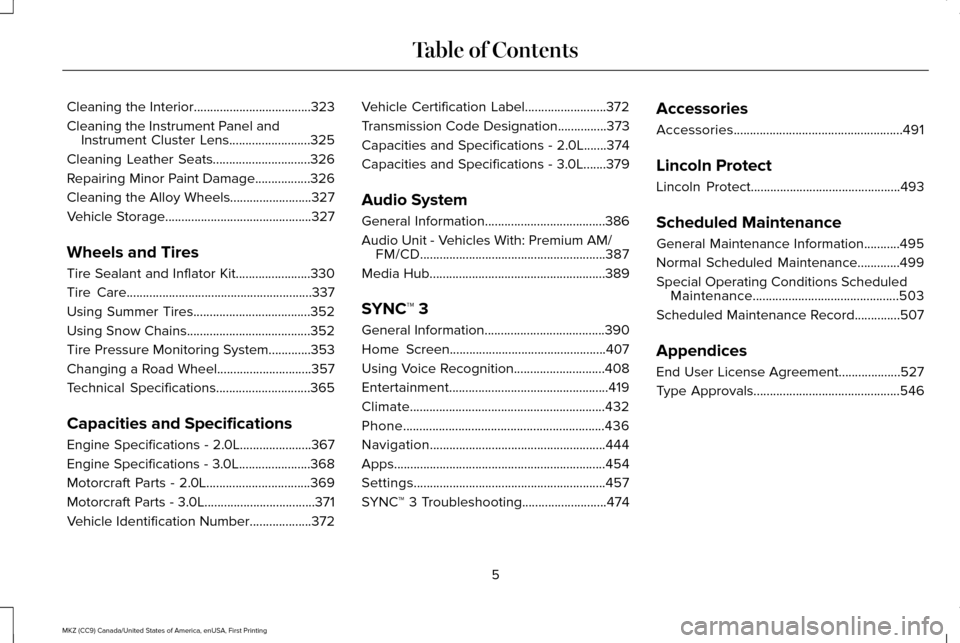
Cleaning the Interior....................................323
Cleaning the Instrument Panel and Instrument Cluster Lens.........................325
Cleaning Leather Seats..............................326
Repairing Minor Paint Damage.................326
Cleaning the Alloy Wheels.........................327
Vehicle Storage
.............................................327
Wheels and Tires
Tire Sealant and Inflator Kit.......................330
Tire Care
.........................................................337
Using Summer Tires
....................................352
Using Snow Chains......................................352
Tire Pressure Monitoring System
.............353
Changing a Road Wheel.............................357
Technical Specifications
.............................365
Capacities and Specifications
Engine Specifications - 2.0L......................367
Engine Specifications - 3.0L......................368
Motorcraft Parts - 2.0L................................369
Motorcraft Parts - 3.0L
..................................371
Vehicle Identification Number...................372 Vehicle Certification Label.........................372
Transmission Code Designation...............373
Capacities and Specifications - 2.0L.......374
Capacities and Specifications - 3.0L.......379
Audio System
General Information.....................................386
Audio Unit - Vehicles With: Premium AM/
FM/CD
.........................................................387
Media Hub......................................................389
SYNC™ 3
General Information
.....................................390
Home Screen
................................................407
Using Voice Recognition............................408
Entertainment.................................................419
Climate............................................................432
Phone..............................................................436
Navigation......................................................444
Apps
.................................................................454
Settings...........................................................457
SYNC™ 3 Troubleshooting..........................474 Accessories
Accessories....................................................491
Lincoln Protect
Lincoln Protect
..............................................493
Scheduled Maintenance
General Maintenance Information...........495
Normal Scheduled Maintenance
.............499
Special Operating Conditions Scheduled Maintenance.............................................503
Scheduled Maintenance Record..............507
Appendices
End User License Agreement...................527
Type Approvals.............................................546
5
MKZ (CC9) Canada/United States of America, enUSA, First Printing Table of Contents
Page 188 of 564
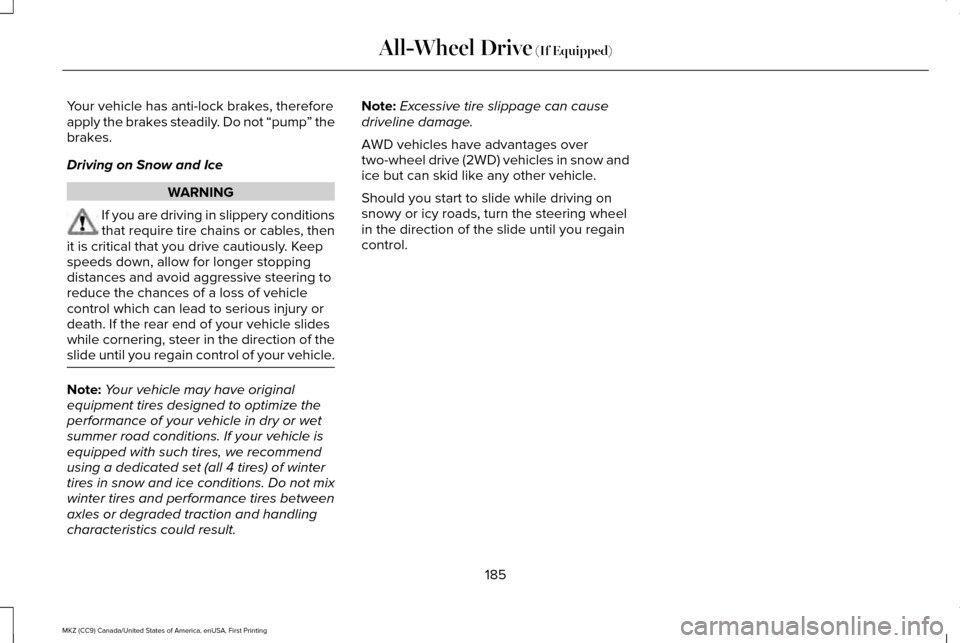
Your vehicle has anti-lock brakes, therefore
apply the brakes steadily. Do not “pump
” the
brakes.
Driving on Snow and Ice WARNING
If you are driving in slippery conditions
that require tire chains or cables, then
it is critical that you drive cautiously. Keep
speeds down, allow for longer stopping
distances and avoid aggressive steering to
reduce the chances of a loss of vehicle
control which can lead to serious injury or
death. If the rear end of your vehicle slides
while cornering, steer in the direction of the
slide until you regain control of your vehicle. Note:
Your vehicle may have original
equipment tires designed to optimize the
performance of your vehicle in dry or wet
summer road conditions. If your vehicle is
equipped with such tires, we recommend
using a dedicated set (all 4 tires) of winter
tires in snow and ice conditions. Do not mix
winter tires and performance tires between
axles or degraded traction and handling
characteristics could result. Note:
Excessive tire slippage can cause
driveline damage.
AWD vehicles have advantages over
two-wheel drive (2WD) vehicles in snow and
ice but can skid like any other vehicle.
Should you start to slide while driving on
snowy or icy roads, turn the steering wheel
in the direction of the slide until you regain
control.
185
MKZ (CC9) Canada/United States of America, enUSA, First Printing All-Wheel Drive (If Equipped)
Page 355 of 564

(depending on tire wear and
environmental conditions) or in snow
and ice conditions. Like any tire, summer
tire performance is affected by tire wear
and environmental conditions. If you
must drive in those conditions, Ford
recommends using Mud and Snow (M+S,
M/S), All-season or Snow tires.
USING SUMMER TIRES
Summer tires provide superior performance
on wet and dry roads. Summer tires do not
have the Mud and Snow (M+S or M/S) tire
traction rating on the tire side wall. Since
summer tires do not have the same traction
performance as All-season or Snow tires, we
do not recommend using summer tires when
temperatures drop to approximately 45°F
(7°C) or below (depending on tire wear and
environmental conditions) or in snow and ice
conditions. Like any tire, summer tire
performance is affected by tire wear and
environmental conditions. If you must drive
in those conditions, we recommend using
Mud and Snow (M+S, M/S), All-season or
Snow tires. Always store your summer tires indoors at
temperatures above 20ºF (-7ºC). The rubber
compounds used in these tires lose flexibility
and may develop surface cracks in the tread
area at temperatures below 20ºF (-7ºC). If
the tires have been subjected to 20ºF (-7ºC)
or less, warm them in a heated space to at
least 40ºF (5ºC) for at least 24 hours before
installing them on a vehicle, or moving the
vehicle with the tires installed, or checking
tire inflation. Do not place tires near heaters
or heating devices used to warm the room
where the tires are stored. Do not apply heat
or blow heated air directly on the tires.
Always inspect the tires after storage periods
and before use.
USING SNOW CHAINS WARNING
Snow tires must be the same size, load
index, and speed rating as those
originally provided by Ford. Use of any tire
or wheel not recommended by Ford can
affect the safety and performance of your
vehicle, which could result in an increased
risk of loss of vehicle control, vehicle rollover,
personal injury, and death. Additionally, the
use of non-recommended tires and wheels
could cause steering, suspension, axle,
transfer case, or power transfer unit failure.
It is also strongly advised to follow the Ford
recommended tire inflation pressure found
on the Safety Compliance Certification Label
(affixed to either the door hinge pillar,
door-latch post, or the door edge that meets
the door-latch post, next to the driver’ s
seating position), or Tire Label which is
located on the B-Pillar or the edge of the
driver door. Failure to follow the tire pressure
recommendations can cause uneven
treadwear patterns and adversely affect the
way your vehicle handles. 352
MKZ (CC9) Canada/United States of America, enUSA, First Printing Wheels and Tires
Page 356 of 564
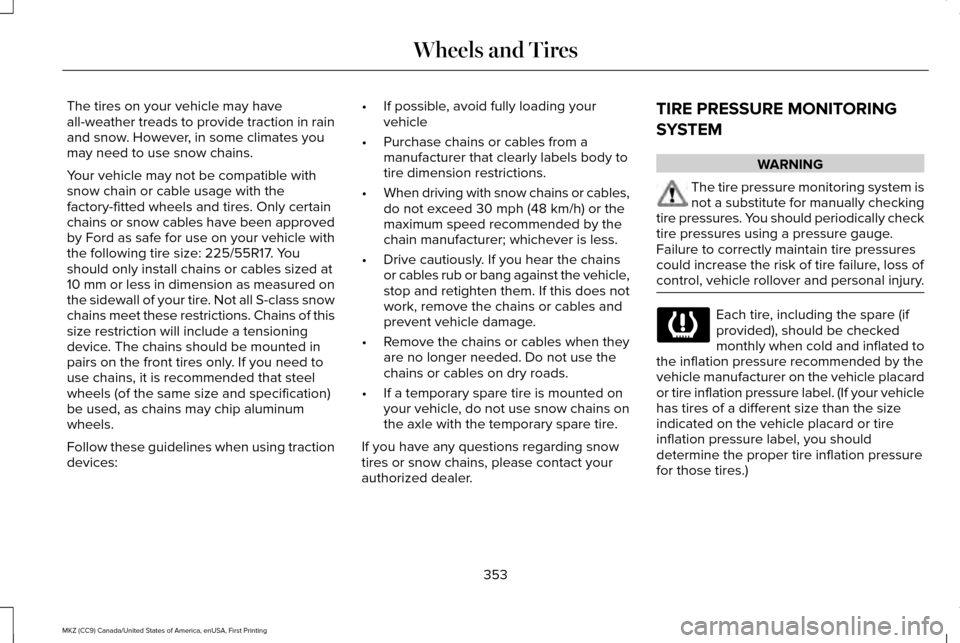
The tires on your vehicle may have
all-weather treads to provide traction in rain
and snow. However, in some climates you
may need to use snow chains.
Your vehicle may not be compatible with
snow chain or cable usage with the
factory-fitted wheels and tires. Only certain
chains or snow cables have been approved
by Ford as safe for use on your vehicle with
the following tire size: 225/55R17. You
should only install chains or cables sized at
10 mm or less in dimension as measured on
the sidewall of your tire. Not all S-class snow
chains meet these restrictions. Chains of this
size restriction will include a tensioning
device. The chains should be mounted in
pairs on the front tires only. If you need to
use chains, it is recommended that steel
wheels (of the same size and specification)
be used, as chains may chip aluminum
wheels.
Follow these guidelines when using traction
devices:
•
If possible, avoid fully loading your
vehicle
• Purchase chains or cables from a
manufacturer that clearly labels body to
tire dimension restrictions.
• When driving with snow chains or cables,
do not exceed 30 mph (48 km/h) or the
maximum speed recommended by the
chain manufacturer; whichever is less.
• Drive cautiously. If you hear the chains
or cables rub or bang against the vehicle,
stop and retighten them. If this does not
work, remove the chains or cables and
prevent vehicle damage.
• Remove the chains or cables when they
are no longer needed. Do not use the
chains or cables on dry roads.
• If a temporary spare tire is mounted on
your vehicle, do not use snow chains on
the axle with the temporary spare tire.
If you have any questions regarding snow
tires or snow chains, please contact your
authorized dealer. TIRE PRESSURE MONITORING
SYSTEM WARNING
The tire pressure monitoring system is
not a substitute for manually checking
tire pressures. You should periodically check
tire pressures using a pressure gauge.
Failure to correctly maintain tire pressures
could increase the risk of tire failure, loss of
control, vehicle rollover and personal injury. Each tire, including the spare (if
provided), should be checked
monthly when cold and inflated to
the inflation pressure recommended by the
vehicle manufacturer on the vehicle placard
or tire inflation pressure label. (If your vehicle
has tires of a different size than the size
indicated on the vehicle placard or tire
inflation pressure label, you should
determine the proper tire inflation pressure
for those tires.)
353
MKZ (CC9) Canada/United States of America, enUSA, First Printing Wheels and Tires
Page 361 of 564
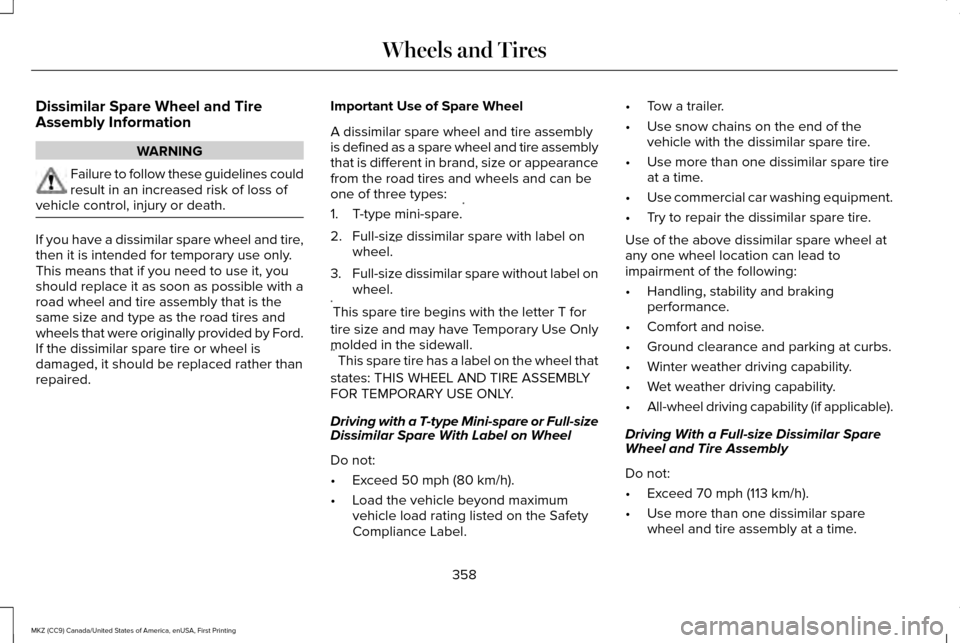
Dissimilar Spare Wheel and Tire
Assembly Information
WARNING
Failure to follow these guidelines could
result in an increased risk of loss of
vehicle control, injury or death. If you have a dissimilar spare wheel and tire,
then it is intended for temporary use only.
This means that if you need to use it, you
should replace it as soon as possible with a
road wheel and tire assembly that is the
same size and type as the road tires and
wheels that were originally provided by Ford.
If the dissimilar spare tire or wheel is
damaged, it should be replaced rather than
repaired.
Important Use of Spare Wheel
A dissimilar spare wheel and tire assembly
is defined as a spare wheel and tire assembly
that is different in brand, size or appearance
from the road tires and wheels and can be
one of three types:
1. T-type mini-spare.
*
2. Full-size dissimilar spare with label on wheel. **
3. Full-size dissimilar spare without label on
wheel.
* This spare tire begins with the letter T for
tire size and may have Temporary Use Only
molded in the sidewall.
** This spare tire has a label on the wheel that
states: THIS WHEEL AND TIRE ASSEMBLY
FOR TEMPORARY USE ONLY.
Driving with a T-type Mini-spare or Full-size
Dissimilar Spare With Label on Wheel
Do not:
• Exceed 50 mph (80 km/h).
• Load the vehicle beyond maximum
vehicle load rating listed on the Safety
Compliance Label. •
Tow a trailer.
• Use snow chains on the end of the
vehicle with the dissimilar spare tire.
• Use more than one dissimilar spare tire
at a time.
• Use commercial car washing equipment.
• Try to repair the dissimilar spare tire.
Use of the above dissimilar spare wheel at
any one wheel location can lead to
impairment of the following:
• Handling, stability and braking
performance.
• Comfort and noise.
• Ground clearance and parking at curbs.
• Winter weather driving capability.
• Wet weather driving capability.
• All-wheel driving capability (if applicable).
Driving With a Full-size Dissimilar Spare
Wheel and Tire Assembly
Do not:
• Exceed 70 mph (113 km/h).
• Use more than one dissimilar spare
wheel and tire assembly at a time.
358
MKZ (CC9) Canada/United States of America, enUSA, First Printing Wheels and Tires
Page 362 of 564
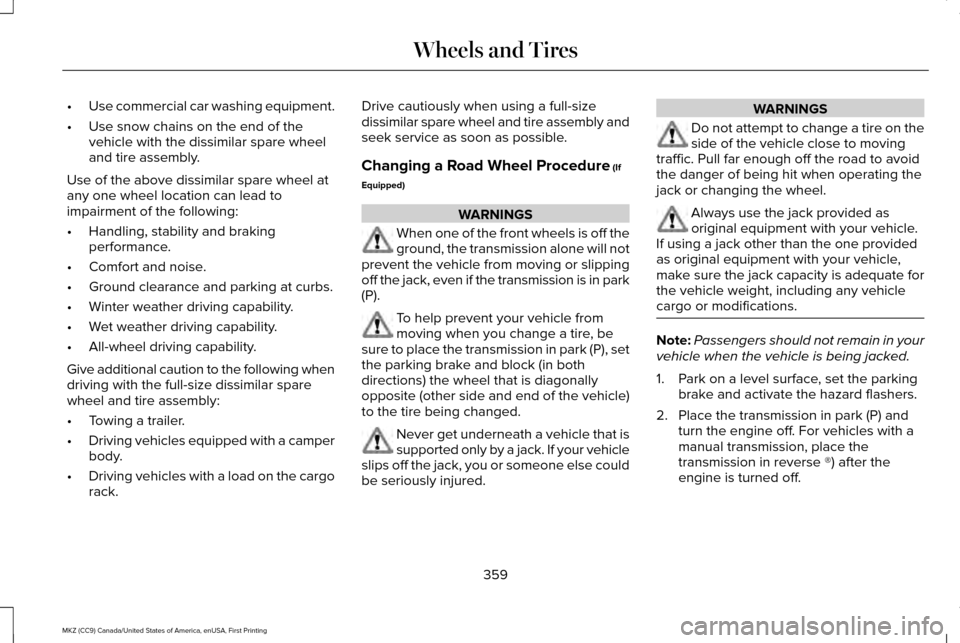
•
Use commercial car washing equipment.
• Use snow chains on the end of the
vehicle with the dissimilar spare wheel
and tire assembly.
Use of the above dissimilar spare wheel at
any one wheel location can lead to
impairment of the following:
• Handling, stability and braking
performance.
• Comfort and noise.
• Ground clearance and parking at curbs.
• Winter weather driving capability.
• Wet weather driving capability.
• All-wheel driving capability.
Give additional caution to the following when
driving with the full-size dissimilar spare
wheel and tire assembly:
• Towing a trailer.
• Driving vehicles equipped with a camper
body.
• Driving vehicles with a load on the cargo
rack. Drive cautiously when using a full-size
dissimilar spare wheel and tire assembly and
seek service as soon as possible.
Changing a Road Wheel Procedure (If
Equipped) WARNINGS
When one of the front wheels is off the
ground, the transmission alone will not
prevent the vehicle from moving or slipping
off the jack, even if the transmission is in park
(P). To help prevent your vehicle from
moving when you change a tire, be
sure to place the transmission in park (P), set
the parking brake and block (in both
directions) the wheel that is diagonally
opposite (other side and end of the vehicle)
to the tire being changed. Never get underneath a vehicle that is
supported only by a jack. If your vehicle
slips off the jack, you or someone else could
be seriously injured. WARNINGS
Do not attempt to change a tire on the
side of the vehicle close to moving
traffic. Pull far enough off the road to avoid
the danger of being hit when operating the
jack or changing the wheel. Always use the jack provided as
original equipment with your vehicle.
If using a jack other than the one provided
as original equipment with your vehicle,
make sure the jack capacity is adequate for
the vehicle weight, including any vehicle
cargo or modifications. Note:
Passengers should not remain in your
vehicle when the vehicle is being jacked.
1. Park on a level surface, set the parking brake and activate the hazard flashers.
2. Place the transmission in park (P) and turn the engine off. For vehicles with a
manual transmission, place the
transmission in reverse ®) after the
engine is turned off.
359
MKZ (CC9) Canada/United States of America, enUSA, First Printing Wheels and Tires
Page 562 of 564
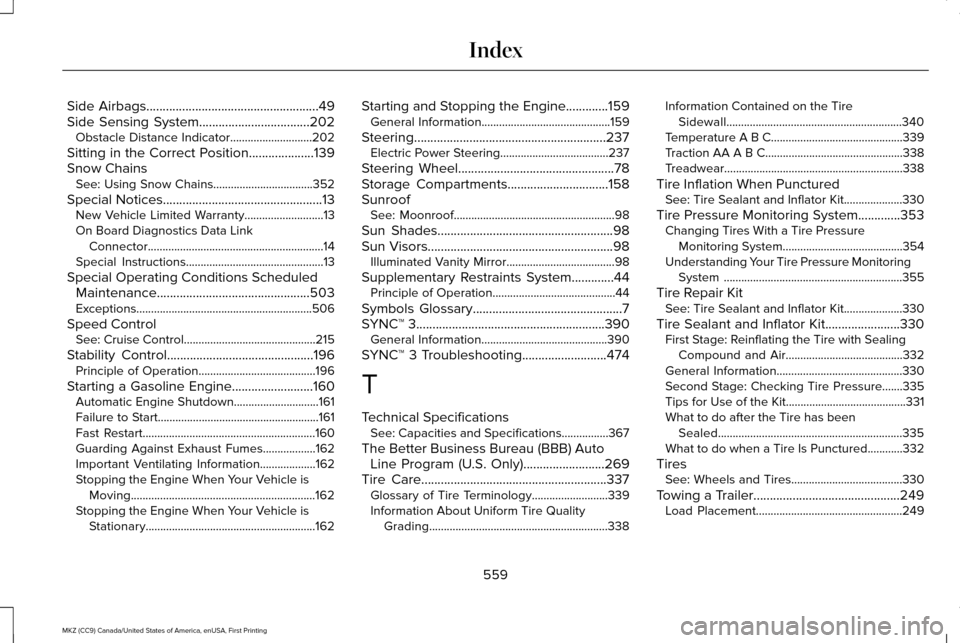
Side Airbags.....................................................49
Side Sensing System..................................202 Obstacle Distance Indicator............................202
Sitting in the Correct Position....................139
Snow Chains See: Using Snow Chains..................................352
Special Notices
.................................................13
New Vehicle Limited Warranty...........................13
On Board Diagnostics Data Link Connector............................................................14
Special Instructions...............................................13
Special Operating Conditions Scheduled Maintenance...............................................503
Exceptions............................................................506
Speed Control See: Cruise Control.............................................215
Stability Control.............................................196 Principle of Operation........................................196
Starting a Gasoline Engine
.........................160
Automatic Engine Shutdown.............................161
Failure to Start.......................................................161
Fast Restart...........................................................160
Guarding Against Exhaust Fumes..................162
Important Ventilating Information...................
162
Stopping the Engine When Your Vehicle is Moving...............................................................162
Stopping the Engine When Your Vehicle is Stationary..........................................................162 Starting and Stopping the Engine.............159
General Information............................................159
Steering...........................................................237 Electric Power Steering.....................................237
Steering Wheel
................................................78
Storage Compartments...............................158
Sunroof See: Moonroof.......................................................98
Sun Shades......................................................98
Sun Visors.........................................................98 Illuminated Vanity Mirror.....................................
98
Supplementary Restraints System
.............44
Principle of Operation..........................................44
Symbols Glossary
..............................................7
SYNC™ 3..........................................................390 General Information...........................................390
SYNC™ 3 Troubleshooting..........................474
T
Technical Specifications See: Capacities and Specifications................367
The Better Business Bureau (BBB) Auto Line Program (U.S. Only).........................269
Tire Care
.........................................................337
Glossary of Tire Terminology..........................339
Information About Uniform Tire Quality
Grading.............................................................338 Information Contained on the Tire
Sidewall............................................................340
Temperature A B C.............................................339
Traction AA A B C...............................................338
Treadwear.............................................................338
Tire Inflation When Punctured See: Tire Sealant and Inflator Kit....................330
Tire Pressure Monitoring System
.............353
Changing Tires With a Tire Pressure
Monitoring System.........................................354
Understanding Your Tire Pressure Monitoring System .............................................................355
Tire Repair Kit See: Tire Sealant and Inflator Kit....................330
Tire Sealant and Inflator Kit.......................330 First Stage: Reinflating the Tire with Sealing
Compound and Air........................................332
General Information...........................................330
Second Stage: Checking Tire Pressure.......335
Tips for Use of the Kit.........................................331
What to do after the Tire has been Sealed...............................................................335
What to do when a Tire Is Punctured............332
Tires See: Wheels and Tires......................................330
Towing a Trailer.............................................249 Load Placement..................................................249
559
MKZ (CC9) Canada/United States of America, enUSA, First Printing Index
Page 563 of 564
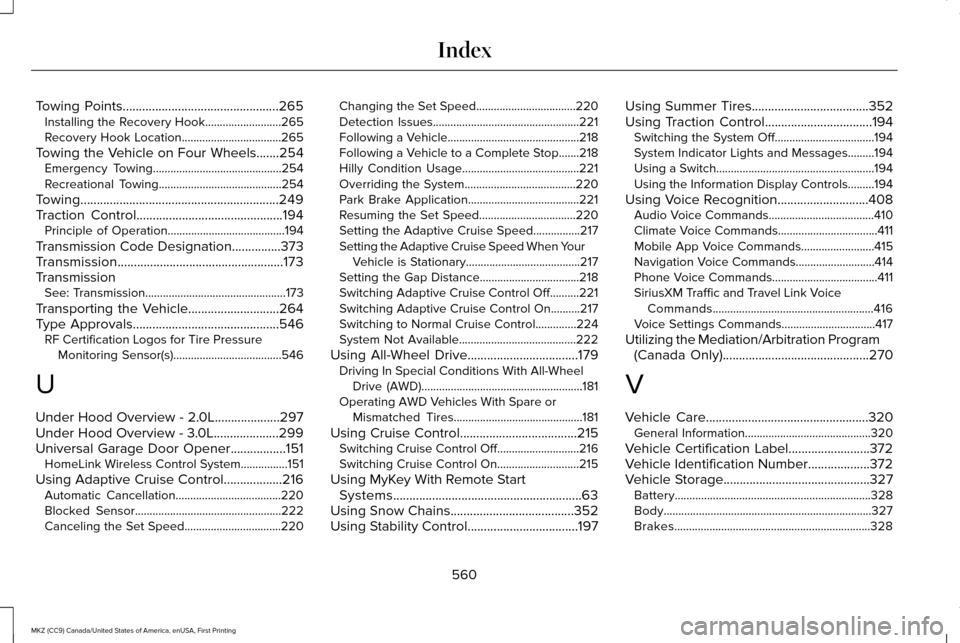
Towing Points................................................265
Installing the Recovery Hook..........................265
Recovery Hook Location..................................265
Towing the Vehicle on Four Wheels
.......254
Emergency Towing............................................254
Recreational Towing..........................................254
Towing.............................................................249
Traction Control.............................................194 Principle of Operation........................................194
Transmission Code Designation...............373
Transmission...................................................173
Transmission See: Transmission................................................173
Transporting the Vehicle............................264
Type Approvals.............................................546 RF Certification Logos for Tire Pressure
Monitoring Sensor(s).....................................546
U
Under Hood Overview - 2.0L
....................297
Under Hood Overview - 3.0L....................299
Universal Garage Door Opener
.................151
HomeLink Wireless Control System................151
Using Adaptive Cruise Control..................216 Automatic Cancellation....................................220
Blocked Sensor..................................................222
Canceling the Set Speed.................................
220 Changing the Set Speed..................................220
Detection Issues..................................................221
Following a Vehicle.............................................218
Following a Vehicle to a Complete Stop.......218
Hilly Condition Usage........................................221
Overriding the System......................................220
Park Brake Application......................................221
Resuming the Set Speed.................................
220
Setting the Adaptive Cruise Speed................217
Setting the Adaptive Cruise Speed When Your Vehicle is Stationary.......................................
217
Setting the Gap Distance..................................218
Switching Adaptive Cruise Control Off..........221
Switching Adaptive Cruise Control On..........217
Switching to Normal Cruise Control..............224
System Not Available........................................222
Using All-Wheel Drive..................................179 Driving In Special Conditions With All-Wheel
Drive (AWD).......................................................181
Operating AWD Vehicles With Spare or Mismatched Tires............................................181
Using Cruise Control....................................215 Switching Cruise Control Off............................216
Switching Cruise Control On............................215
Using MyKey With Remote Start Systems..........................................................63
Using Snow Chains......................................352
Using Stability Control
..................................197 Using Summer Tires
....................................352
Using Traction Control.................................194 Switching the System Off..................................194
System Indicator Lights and Messages.........
194
Using a Switch......................................................194
Using the Information Display Controls.........194
Using Voice Recognition............................408 Audio Voice Commands....................................410
Climate Voice Commands..................................411
Mobile App Voice Commands.........................415
Navigation Voice Commands...........................414
Phone Voice Commands....................................411
SiriusXM Traffic and Travel Link Voice
Commands.......................................................416
Voice Settings Commands................................417
Utilizing the Mediation/Arbitration Program (Canada Only)
.............................................270
V
Vehicle Care
..................................................320
General Information...........................................320
Vehicle Certification Label.........................372
Vehicle Identification Number...................372
Vehicle Storage
.............................................327
Battery...................................................................328
Body.......................................................................327
Brakes...................................................................328
560
MKZ (CC9) Canada/United States of America, enUSA, First Printing Index